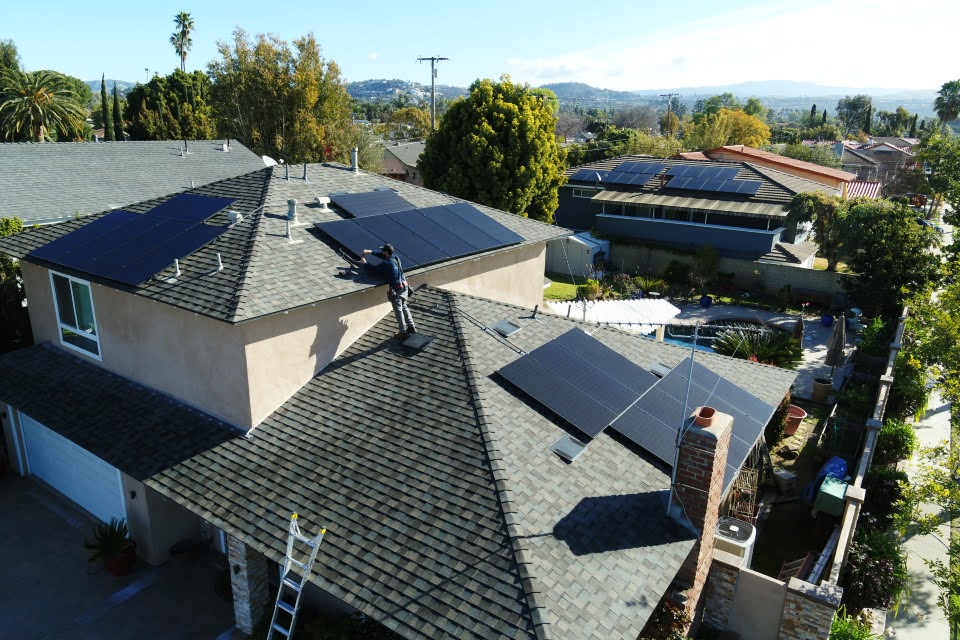While going solar has many benefits, most homeowners install solar panels for the savings on their energy bills. When you can generate electricity at home, you don't need to draw as much energy from the grid.
But there are long periods of the day when your rooftop solar panels may produce more energy than your home needs. When this happens, you really don't want that clean energy to be wasted. Enter net metering.
Net metering is a mechanism that creates even more solar savings. This articles examines 10 common questions about what net metering is, how it works, and what it means for solar and battery storage systems.
1. What is net metering?
Solar panels usually generate most of their power in the middle of the day and during the afternoon, which is often when homeowners use the least amount of electricity. Typically, homes use the most energy during the morning and evenings, which is when solar production is lower. That means that you may have a big surplus of solar energy that you're not using in the middle of the day.
Net metering allows you to feed that surplus energy from your panels into your local electric grid so that it doesn't go to waste. In return, you receive credits on your energy bill, which you can use to offset future bills. If your panels aren't producing enough power to meet your needs in the evening, for instance, you have to draw power from the grid. You'll be able to offset that cost with the net metering credits you've earned from selling back your surplus solar power.
Photo courtesy Orange County Solar, Irvine, CA
2. How does net metering work?
When your solar panels produce more electricity than you can use, your electricity meter runs in reverse so that this excess energy is sent back to your local grid. When this happens, you receive a credit on your energy bill for every kilowatt-hour (kWh) of electricity that you give back.
Conversely, when your solar panels don't produce enough electricity for your home, you will need to use electricity from the grid to meet the deficit. This is when you can use any credits that you have accrued to decrease your electricity bills.
One myth about net metering is that it reduces revenue for utility companies. But, as the Solar Energy Industries Association (SEIA) notes, net metering helps smooth the demand curve for electricity. That actually helps utilities to manage peak loads and operate more efficiently.
Moreover, solar energy systems supported by net metering help to shift the production of electricity closer to the point of consumption. That reduces strain on distribution systems and decreases the amount of electricity lost in the transmission process.
3. What states offer net metering?
Almost all states offer some kind of financial incentive for utility customers who sell excess solar power back to the grid, whether it's net metering or a similar compensation program. As of August 2021, only South Dakota, Tennessee, and Alabama had no type of compensation. The specific details and requirements do vary from state-to-state, so check the Database of State Incentives for Renewables and Efficiency to see what incentives your state offers.
Some states are beginning to re-evaluate their net metering programs. Most famously, California moved to a new net metering policy in April 2023. Under the new rules, known as NEM 3.0, California homeowners get much less money (about 75% less) for every kWh they give back. The exact amount varies by the time of day and the month. North Carolina is also moving to a variable net metering structure.
4. How much can net metering save you?
Your utility will pay you for every kilowatt-hour of solar energy you send back to the grid. This credit is usually equal to the full retail price of electricity, but it does vary by state. You can potentially save tens of thousands of dollars on your electricity bills over the lifetime of your solar system. Take a look at this calculator to receive a more accurate estimate for your home.
With the savings from net metering, you can reduce the payback period for your rooftop solar system to between four and nine years. The savings depends, in part, on where you live, how much your solar system cost, and your electricity rates.
5. Will I receive cash payments with net metering?
No. Instead, you receive credits on your utility bill for any electricity that you feed back into the grid. You can use those credits when you have to draw electricity from the grid (e.g., at night or in the winter) because your solar panels aren't producing as much energy.
6. How is net metering different from battery storage?
With net metering, you sell surplus electricity that your solar panels produce back to the grid for credits. If you have a battery storage system, any surplus solar electricity gets stored in your battery for you to use later. Both options can save you money, but there are some differences in their other benefits. More on that below.
7. Should I use battery storage or net metering?
Batteries and net metering are both valuable ways to ensure that none of your solar electricity gets wasted when you're not around to use it. Net metering can be a lucrative incentive that allows you to shore up credits from your surplus solar power to decrease your payments on future bills. However, not all states offer net metering, and some are re-evaluating their measures.
Because batteries are independent of the grid, they offer homeowners a valuable alternative. They can provide round-the-clock backup power during power outages and can even lower your energy bills. For example, if your utility charges time-of-use rates, you can use power from your battery when rates are high and grid electricity when rates come down again.
8. Can batteries be used with net metering?
In most states, if you send stored solar energy from your batteries back to the grid, you won't be eligible for net metering credits. However, several states are reviewing their policies on this.
Utilities have started to offer bring-your-own-battery or bring-your-own-device programs that provide financial incentives (either payments or bill credits) to homeowners who allow the utility to draw power from their battery at specific times. Being able to draw on batteries helps utilities balance the grid and keep power flowing at peak times, like during summer heat waves.
9. How does net metering support a net-zero home?
Having a net-zero home doesn't mean that you never use power from the grid. Instead, it means that your home produces as much electricity as it uses. Put another way, your solar panels will produce at least as much electricity as you consume over the course of the year.
In this way, net metering supports homeowners in transitioning toward net-zero because it enables you to balance the energy output from your solar panels with your energy usage in the home. You can achieve a similar effect with batteries.
10. What are the eligibility criteria for net metering?
To be eligible for net metering, you must generate at least some of your own energy from a renewable source, often rooftop solar panels. Other criteria and requirements vary by state and utility. Your solar installer should be able to help you determine whether you're eligible for net metering in your state.
Ready to go solar to lower your energy bills, reduce your dependence on the power grid, and improve the efficiency of your home? Panasonic has the tools and resources to help you every step of the way. Learn more about how we can help you find the best energy solution for your home.






